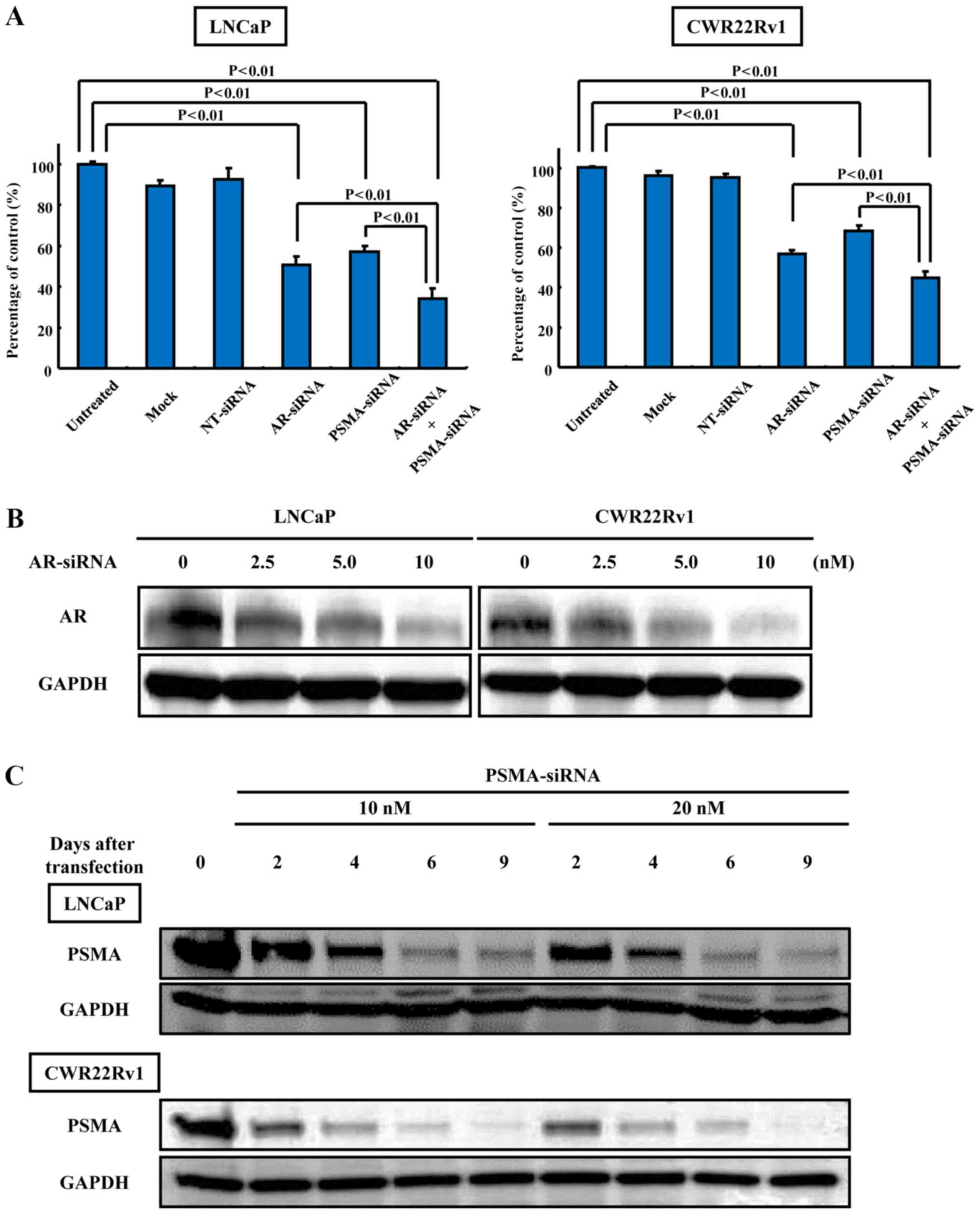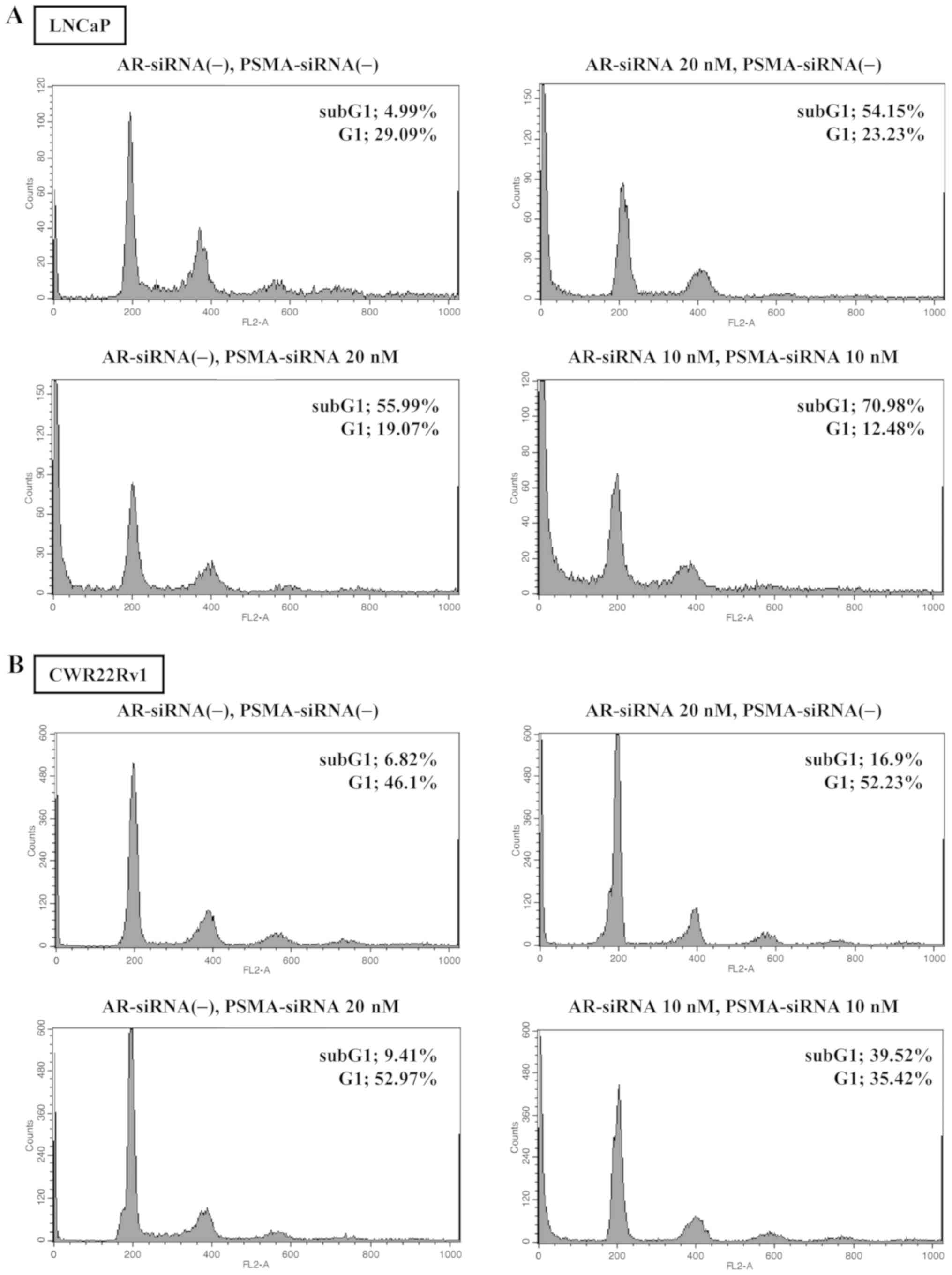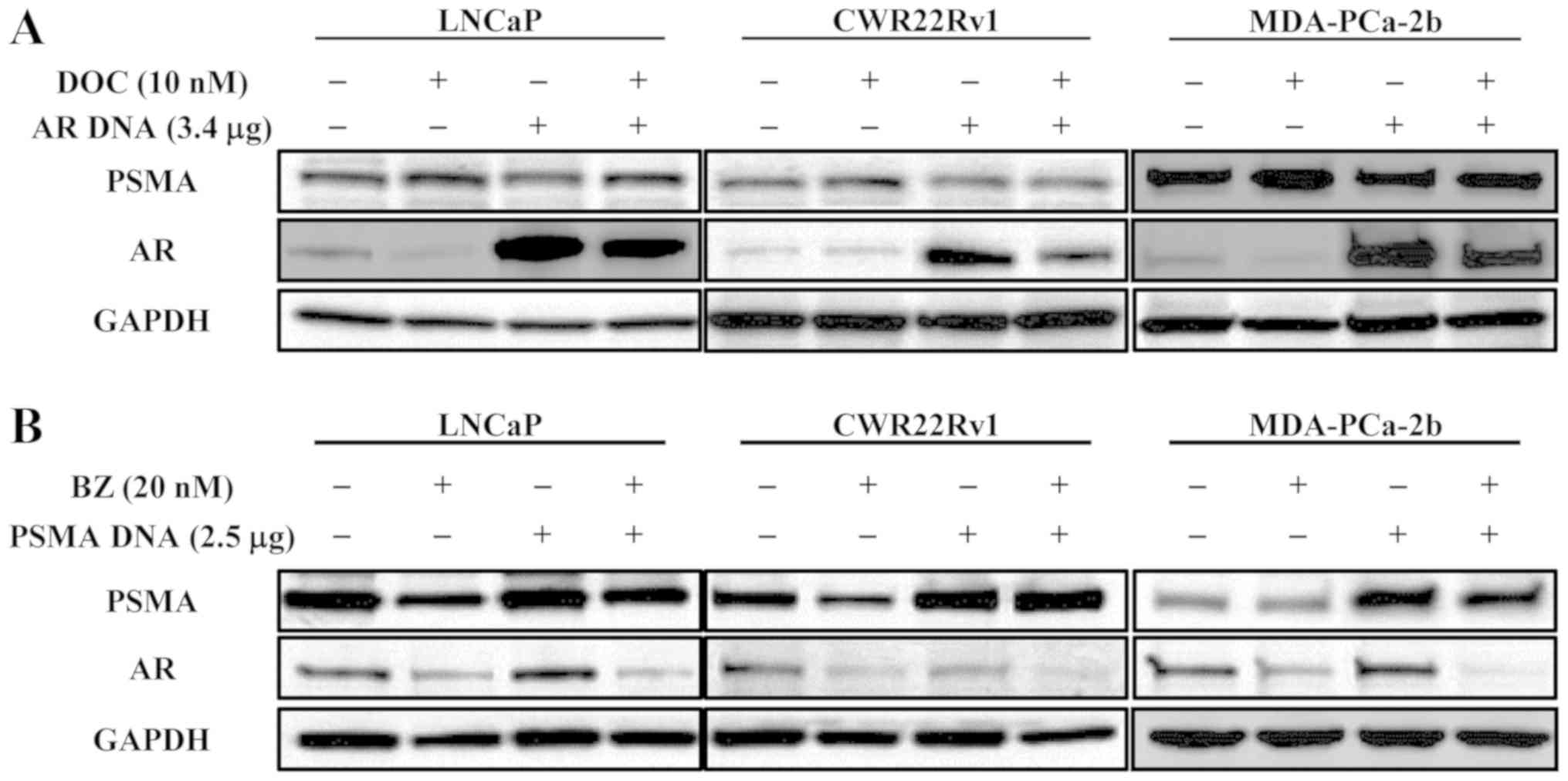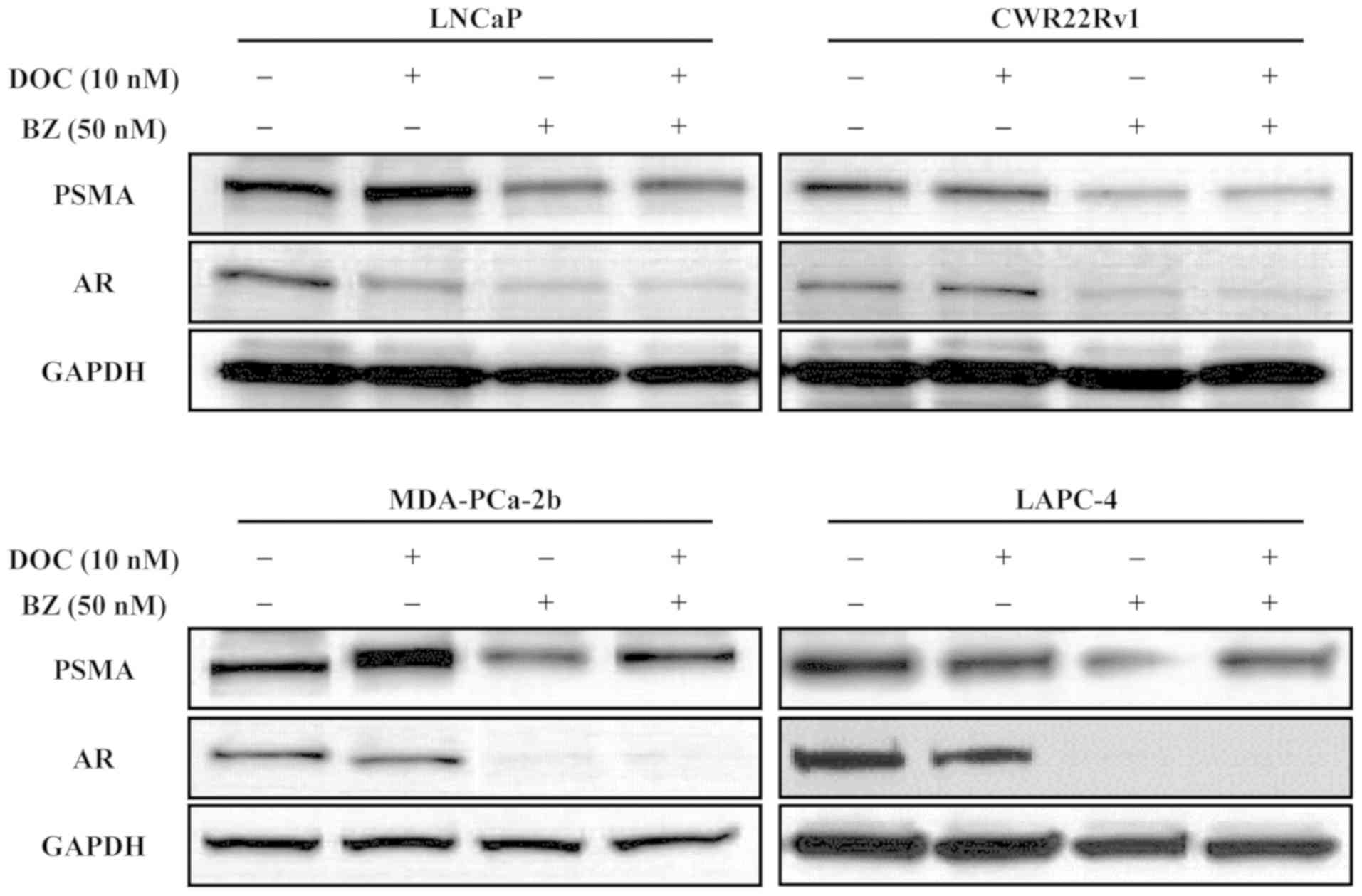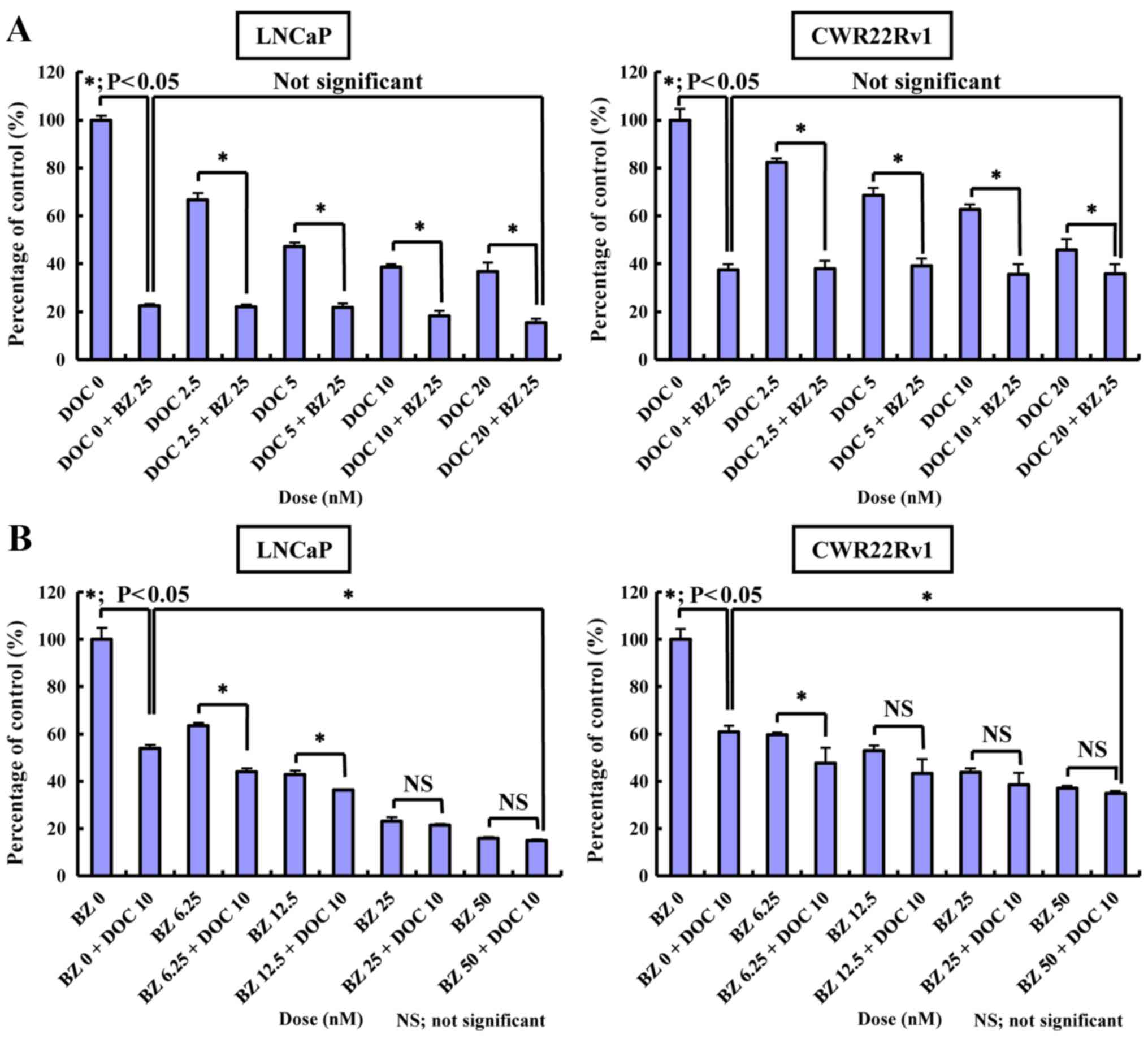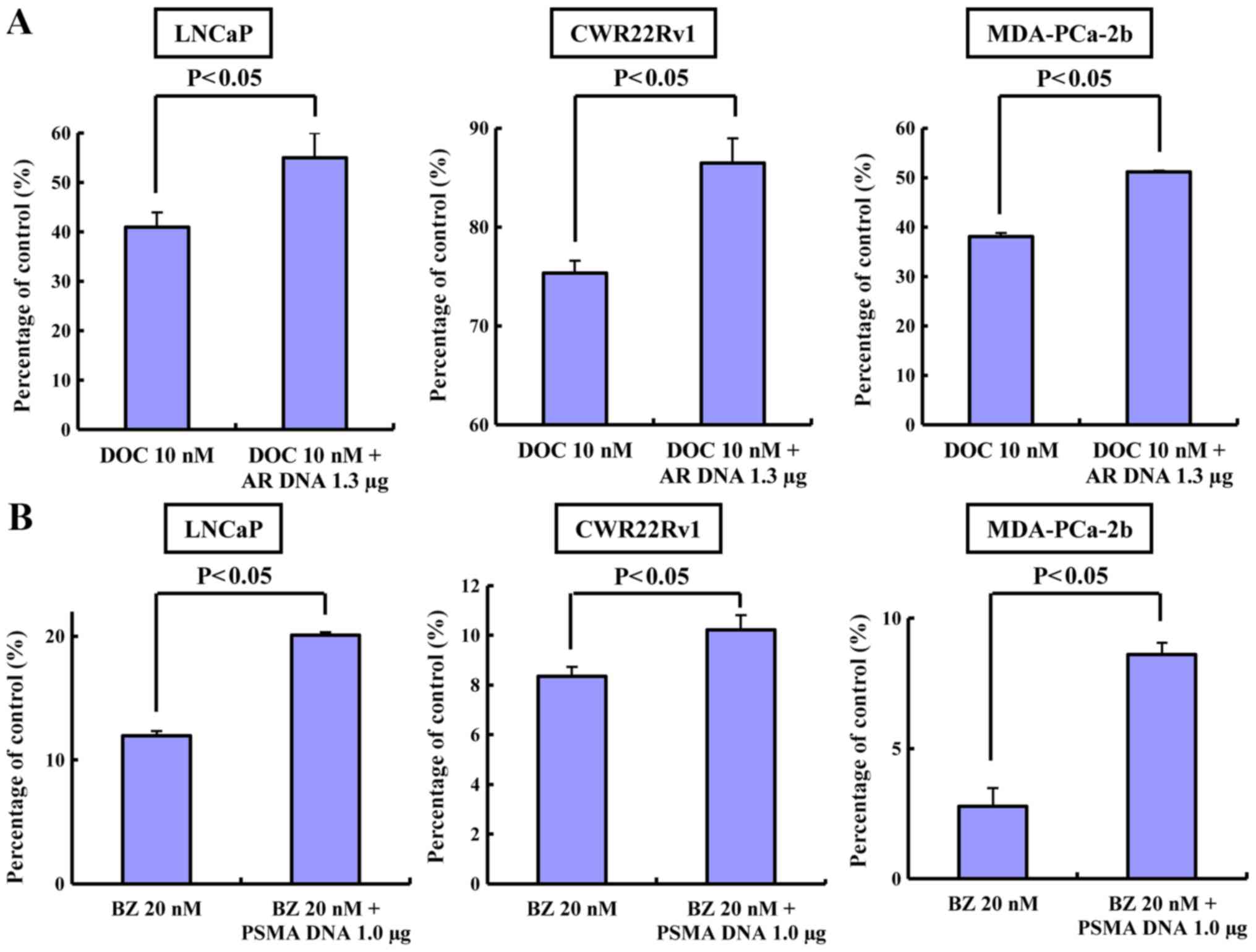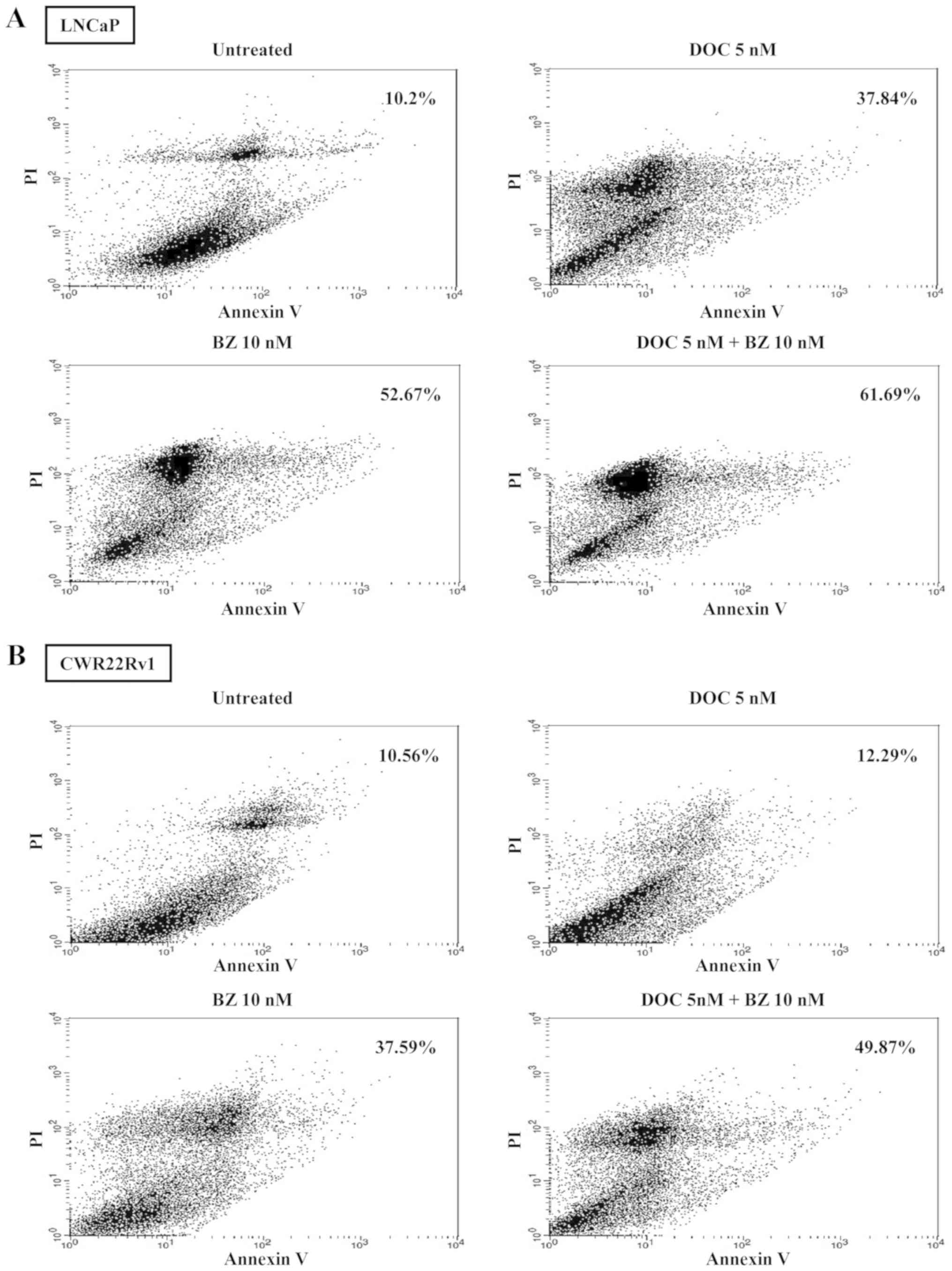The proteasome inhibitor, bortezomib, induces prostate cancer cell death by suppressing the expression of prostate-specific membrane antigen, as well as androgen receptor
- Authors:
- Published online on: February 1, 2019 https://doi.org/10.3892/ijo.2019.4706
- Pages: 1357-1366
Abstract
Introduction
The growth of primary prostate cancer (PC) is dependent on androgens (1). Androgen ablation therapy through chemical castration with a luteinizing hormone-releasing hormone agonist, in combination with non-steroidal androgen receptor (AR) antagonists, is often used to impede the growth of PC (2,3). Although there is an initial regression in cancer growth, PC almost always progresses to a more aggressive castration-resistant form, which can be accompanied by the appearance of bone metastases (4).
A tumor biomarker of PC, i.e., prostate-specific membrane antigen (PSMA), is expressed in primary carcinomas and an increase in PSMA expression has been shown to be associated with tumor grade, pathological stage and aneuploidy (5). PSMA expression is also upregulated with the transition from androgen-sensitive PC to castration-refractory PC (6). Since PSMA is predominantly expressed in the prostate epithelium and the neovasculature of solid tumors (7,8), it can be an excellent candidate in PSMA-targeted therapy.
Bortezomib (BZ; PS-341) is a boronic acid dipeptide that inhibits 26S proteasome activity (9). The antitumor effects of BZ have been extensively studied in multiple myeloma (MM) cells. BZ has been shown to inhibit the proliferation of and induce the apoptosis of MM cells in vitro, and in an MM murine model via the inactivation of nuclear factor-κB (NF-κB) (10-13). BZ has also been shown to overcome drug resistance and potentiate the anticancer effects of conventional therapeutic agents (14-16). Moreover, a previous clinical study using BZ in individuals with relapsed, refractory MM have demonstrated objective responses, some of which were complete responses (17). Although BZ appears to be a promising therapeutic agent for MM, its activity against non-hematological malignancies, including PC remains to be elucidated, regardless of its potent anticancer effects on MM cells.
The results of our preliminary experiments to evaluate the effects of BZ treatment on PC cells suggested that BZ exerts an inhibitory effect on PSMA expression (data not shown). Therefore, the detailed functions of BZ in PC cells should be defined. It was previously observed that docetaxel (DOC) exerts a suppressive effect on AR expression, but not on PSMA expression (18). Thus, distinguishing between the effects of DOC and BZ on protein expression is an intriguing line of investigation.
In this study, we examined the effects of BZ on protein expression in PC cells and compared its anticancer effects on the growth of PC cells treated with BZ, DOC, or a combination of both.
Materials and methods
Cell lines and reagents
The human PC cell lines, LNCaP, CWR22Rv1, MDA-PCa-2b and LAPC-4, were purchased from the American Type Culture Collection (ATCC, Manassas, VA, USA). The LNCaP and CWR22Rv1 cells were maintained in RPMI-1640 medium supplemented with 2 mM L-glutamine, 1% penicillin-streptomycin, and 10% heat-inactivated fetal bovine serum (FBS) (all from Invitrogen/Thermo Fisher Scientific, Waltham, MA, USA). The MDA-PCa-2b cells were grown in F12K medium containing 2 mM L-glutamine, 1% penicillin-streptomycin, 20% heat-inactivated FBS, 25 ng/ml cholera toxin (Sigma-Aldrich, St. Louis, MO, USA), 10 ng/ml epidermal growth factor (BD Biosciences, Franklin Lakes, NJ, USA), 5 µM phosphoethanolamine, 100 pg/ml hydrocortisone, 45 nM selenious acid and 5 µg/ml insulin (all from Sigma-Aldrich). The LAPC-4 cells were maintained in IMDM medium supplemented with 2 mM L-glutamine, 1% penicillin-streptomycin and 5% heat-inactivated FBS. All the cell lines were kept at 37°C in a 5% CO2 atmosphere. DOC was purchased from Sanofi-Aventis (Bridgewater, NJ, USA). BZ was purchased from Tronto Research Chemicals (North York, ON, Canada).
RNA interference
Small interfering RNA (siRNA) duplexes specific to AR and PSMA and random siRNA were purchased from Dharmacon (Lafayette, CO, USA). The sequence of AR-specific siRNA (AR-siRNA) corresponds to the human AR site was 5′-GACUCAGCUGCCCCAUCCA-3′) (19). The PSMA-specific siRNA (PSMA-siRNA) is a custom product (siGENOME Duplex D-005881-04-0050, Human FOLH1, NM_004476). A non-targeting siRNA (NT-siRNA) (5′-CCUACGCCACCAAUUUCGU-3′) was used as a control for the RNA interference experiments (20). Following overnight incubation of the suspended cells at 37°C transfected with 10-40 nM of AR- or PSMA-siRNA or NT-siRNA using Lipofectamine RNAiMAX reagent (Invitrogen/Thermo Fisher Scientific) according to the manufacturer's instructions, the media were changed with fresh media and the cells were incubated at 37°C with or without the drugs for the time indicated in the Figures and Figure legends.
Cell cycle analysis
All cell lines were first incubated in 6-well plates (2.5x105 cells/well) overnight and then transfected with 10 nM of AR-siRNA and/or 10 nM of PSMA-siRNA for 72 h. Subsequently, the cells were prepared for cell cycle analysis using the Cell Cycle Phase Determination kit (Cayman Chemical Co., Ann Arbor, MI, USA) according to the manufacturer's instructions. Briefly, the cells were trypsinized, collected and centrifuged to the pellet. The cell pellet was fixed in fixative included in the kit for at least 2 h at -20°C prior to propidium iodide (PI) staining after being washed 2 times with assay buffer also in the kit. After the fixed cells were centrifuged at 500 x g for 5 min and the fixative was thoroughly removed, the cell pellet was suspended in PI solution and incubated for 30 min at room temperature in the dark. The samples were subjected to FACScan flow cytometer and analyzed using CellQuest software (both from BD Biosciences).
Western blot analysis
The cells were lysed with Cell Lysis Buffer (Cell Signaling Technology, Danvers, MA, USA) containing 1 mM phenylmethylsulphonyl fluoride (EMD Chemicals, Gibbstown, NJ, USA). Equal amounts of proteins (40-60 µg for each) determined by the Lowry method (DC protein assay reagents) were applied to each well on a 10% Tris-HCl gel (both from Bio-Rad Laboratories, Hercules, CA, USA). The proteins were transferred onto Immobilon-P Membranes (Millipore, Billerica, MA, USA), after which the filters were washed with 15 ml of Tris-buffered saline (Bio-Rad Laboratories) with Tween-20 (TBST) containing 5% bovine serum albumin (Sigma-Aldrich) 3 times for 5 min each at room temperature, and probed with solutions containing the following reagents: Mouse monoclonal anti-PSMA antibody J591 (generated and purified in Dr Neil Bander's laboratory) (dilution 1:4,000) (8), mouse monoclonal antibody anti-AR (sc-7305) (Santa Cruz Biotechnology, Santa Cruz, CA, USA) (dilution 1:100), goat polyclonal antibody anti-glyceraldehyde-3-phosphate dehydrogenase (sc-31915) (GAPDH; Santa Cruz Biotechnology) (dilution 1:100). The temperature and duration of the incubation with the primary and secondary antibodies were 4°C overnight, and room temperature for 1 h, respectively. After these steps, proteins were detected using ECL Plus Western blotting detection reagents (GE Healthcare, Chicago, IL, USA).
AR and PSMA DNA transfection
For all transfections, the LNCaP, CWR22Rv1 and MDA-PCa-2b cells were seeded at 2x105 cells/well in 1 ml of complete media in 12-well plates or 3.5x105 cells/well in 2 ml of complete media in 6-well plates on the day before transfection. Subsequently, 1.3 µg (for 12-well) or 3.4 µg (for 6-well) of AR DNA, or 1.0 µg (for 12-well) or 2.5 µg (for 6-well) of PSMA DNA were mixed with 1 µl (for 12-well) or 2.5 µl (for 6-well) of PLUS reagent (Invitrogen/Thermo Fisher Scientific) in 200 µl (for 12-well) or 500 µl (for 6-well) of serum-free media (Opti-MEM® I Reduced Serum Media; Invitrogen/Thermo Fisher Scientific) for 10 min. A total of 4 µl (for 12-well) or 11.25 µl (for 6-well) of Lipofectamine LTX (Invitrogen/Thermo Fisher Scientific) was then added, mixed and incubated for an additional 25 min before the mixture of DNA, PLUS reagent and Lipofectamine LTX was added dropwise to the cells. The cells were then incubated for 48 h at 37°C, 5% CO2 prior to the addition of 10 nM of DOC to the cells transfected with AR DNA or 20 nM of BZ to the cells transfected with PSMA DNA. Following treatment with DOC or BZ for an additional 48 h, the cells in the 12-well plates were subjected to cell counting by flow cytometry, and those in the 6-well plates were subjected to western blot analysis.
For cell counting, the cells were first incubated overnight in 24-well plates (4x104 cells/well) and then treated for various periods of times with several methods. The media from each well were then discarded. Subsequently, 300 µl of 0.1% trypsin was placed in each well for 8 min at 37°C followed by 700 µl of fresh media containing 10% FBS, and the cells were collected. A total of 50 µl of SPHERO™ (Spherotech, Lake Forest, IL, USA) was then added to each sample, and the cells were then subjected to flow cytometry (BD Biosciences). The data were analyzed using CellQuest software (BD Biosciences) according to the manufacturer's instructions.
Cell viability assay
MTT assay was used to assess cell viability following treatment of the PC cells. The cells were seeded in 96-well plates (5x103 cells/well), grown overnight, and then treated for various periods of time as indicated in the results and/or figure legends. Subsequently, 10 µl of MTT reagent (R&D Systems, Minneapolis, MN, USA) were added to each well. The plates were incubated for approximately 4 h at 37°C. When purple precipitate was clearly visible grossly, 100 µl of detergent reagent (R&D Systems) was added to all wells, including the control wells. The color change was measured at 570 nm with a reference wavelength of 650 nm on a Spectramax 340PC Microplate Reader (Molecular Devices Corporation, Sunnyvale, CA, USA) following overnight incubation at room temperature.
Apoptotic cell detection
The LNCaP and CWR22Rv1 cells were seeded in 6-well plates (1x105/well), grown overnight, and then treated with 5 nM of DOC and/or 10 nM of BZ for 72 h. Following treatment, the cells trypsinized were collected and centrifuged at 1,000 x g for 5 min at room temperature, and then resuspended in 500 µl of binding buffer (MBL International, Woburn, MA, USA). Subsequently, 5 µl of Annexin V-conjugated fluorescein isothiocyanate (FITC) and 5 µl of PI (both from MBL International) were added into each binding buffer containing the suspended cells. Following a 5-min incubation at room temperature in the dark, the cells were subjected to FACScan flow cytometer (BD Biosciences). The data were analyzed using CellQuest software (BD Biosciences) according to the manufacturer's instructions.
Statistical analysis
All values in bar graphs are expressed as the means ± standard deviation, and variables for different groups were compared using one-way analysis of variance (ANOVA) with Tukey's post hoc test, and a value of P<0.05 was considered to indicate a statistically significant difference. Statistical analyses were performed with JMP version 8.0 (SAS Institute, Cary, NC, USA).
Results
Effect of AR- and/or PSMA-siRNA on cell growth and protein expression
The knockdown effect of AR- or PSMA-siRNA transfection on cell growth and protein expression in the LNCaP and CWR22Rv1 cells was examined. The knockdown of both AR and PSMA suppressed cell growth more significantly (33.89±5.42 and 45.00±3.00%) than AR alone (50.50±4.36 and 56.92±1.81%) or PSMA alone (57.21±2.43 and 68.18±2.93%) in the LNCaP and CWR22Rv1 cells, respectively (Fig. 1A). There was also a significant difference in growth between the cells transfected with AR- or PSMA-siRNA or both and the untreated cells in the LNCaP and CWR22Rv1 cells (Fig. 1A). No statistically significant difference in cell growth between the AR-siRNA-transfected cells and PSMA-siRNA-transfected cells was observed (Fig. 1A). The expression levels of AR and PSMA were sufficiently downregulated following the knockdown of AR or PSMA using siRNA specific to AR or PSMA (Fig. 1B and C).
Cell cycle analysis in cells treated with AR- and/or PSMA-siRNA transfection
The percentage of sub-G1 in the cells transfected with AR-siRNA alone (20 nM), or PSMA-siRNA alone (20 nM), or AR-siRNA (10 nM) plus PSMA-siRNA (10 nM) for 72 h was 54.15, 55.99 and 70.98%, respectively in the LNCaP cells, and 16.90, 9.41 and 39.52%, respectively in the CWR22Rv1 cells (Fig. 2A and B).
Effect of DOC on protein expression in cells transfected with AR DNA and that of BZ on protein expression in those transfected with PSMA DNA
The effects of DOC on the LNCaP, CWR22Rv1 and MDA-PCa-2b cells, and on the cells transfected to highly express AR were examined. Even under the condition of AR upregulation, DOC inhibited the expression of AR, but not that of PSMA, in all of the cell lines tested (Fig. 3A). The effects of BZ were also examined using the same cell lines transfected with PSMA DNA. BZ decreased both AR and PSMA expression in normal cells and in the cells transfected to upregulate PSMA in every cell line tested (Fig. 3B).
Effect of DOC and/or BZ on the expression of AR and PSMA
The effects of DOC and/or BZ on the expression of proteins, including AR and PSMA in the LNCaP, CWR22rv1 and MDA-PCa-2b cells incubated with 10 nM DOC, and/or 50 nM BZ for 48 h were evaluated. DOC inhibited the expression of AR in all the cell lines tested in a dose-dependent manner; however, it did not suppress PSMA expression in any of the cell lines tested (Fig. 4). On the other hand, BZ inhibited the expression of both AR and PSMA expression in all the cell lines tested (Fig. 4).
Inhibitory effect of BZ and/or DOC on normal cells or those transfected to upregulate AR or PSMA
The inhibitory effects of BZ and/or DOC on normal cells or cells transfected to overexpress AR or PSMA were also evaluated. The results of MTT assay revealed that BZ itself exerted a significantly potent anticancer effect on the cell lines tested with or without the administration of DOC (Fig. 5). Cell growth was not inhibited compared to the normal cells in all the cell lines transfected to overexpress AR or PSMA, which were respectively treated with DOC or BZ (Fig. 6A and B).
Apoptotic cell detection in cells treated with BZ and/or DOC
The percentages of late apoptotic cells detected using Annexin V and propidium iodide staining, which were used with DOC alone (5 nM), BZ alone (10 nM), or DOC (5 nM) plus BZ (10 nM) for 72 h, were 37.84, 52.67 and 61.69%, respectively in the LNCaP cells and 12.29, 37.59 and 49.87%, respectively in the CWR22Rv1 cells (Fig. 7).
Discussion
Previous research suggests that PSMA expression is modulated inversely by the expression level of androgens. In other words, PSMA expression is upregulated when AR expression is downregulated and vice versa (6,21). It was previously confirmed that saporin-conjugated, anti-PSMA antibodies have potent and selective anticancer effects on PSMA-expressing PC cells in vitro and in vivo (22). The same effects were observed by immunohistochemistry in the downregulation of PSMA, particularly in inoculated tumors (22). These results indicate that along with decreased levels of PSMA, AR expression may be downregulated. Consequently, the viability of PC cells could be significantly reduced by the simultaneous knockdown of PSMA and AR. As stated in this study in the Introduction, BZ was found to exert an inhibitory effect on PSMA expression in our preliminary experiments. The present study verified whether the anticancer effect of BZ is dependent on decreased expression levels of both AR and PSMA.
Based on these previous findings, this study investigated the anticancer effect of BZ on PC cell lines compared to DOC alone or BZ plus DOC after confirming the inhibitory effect of siRNA on cell growth, the expression of PSMA as well as AR, and the cell cycles (Figs. 1 and 2). The results suggested that the simultaneous knockdown of AR and PSMA exerted sufficient growth inhibitory effects on PC cells. These phenomena were tested and confirmed using the cells transfected to overexpress AR or PSMA to determine whether DOC exerts an inhibitory effect on AR expression or whether BZ exerts a suppressive effect on PSMA expression even in the cells transfected to upregulate AR or PSMA expression (Figs. 3 and 4). These findings were similar to those observed with both AR- and PSMA-siRNA on cell growth, protein expression and cell cycle analysis observed in Figs. 1 and 2. Based on these findings, a bona-fide inhibitory effect on cell growth in PC cells was examined. We do assert that BZ has an inhibitory effect on the expression of both AR and PSMA. However, the expression levels of AR and PSMA are inversely correlated. When AR expression is upregulated, PSMA expression is downregulated (6). Therefore, we did not use cell lines transfected with AR DNA for examining the effect of BZ on AR expression, as we suspected that PSMA expression would be relatively low in such cell lines with the effect of BZ not sufficiently significant. The effect of BZ alone on cell growth was found to be sufficiently potent when compared to the effect of DOC alone or to that of the combined administration of both drugs on LNCaP and CWR22Rv1 cells. Furthermore, BZ inhibited the growth of the two cell lines in a dose-dependent manner (Fig. 5). We believe that AR and PSMA play essential roles in enabling cells to survive the treatment of anticancer drugs, such as DOC and BZ (23-26). In fact, we demonstrated that cells transfected with AR DNA or PSMA DNA were resistant to the inhibitory effects of DOC and BZ on the growth of the cells (Fig. 6). In detecting apoptotic cells by fluorescence-activated cell sorting (FACS) analysis, the apoptosis-inducing effect on the cells treated with BZ alone was close to that observed with treatment with BZ plus DOC, but more potent than that observed with treatment with DOC alone (Fig. 7). The dose of BZ and DOC tested was designated appropriately in this series of experiments we conducted, and was within a normal limitation (16,18). Based on these findings, BZ induced the apoptosis of the cells expressing AR, as well as PSMA by suppressing both the expression of both proteins, and the apoptosis-inducing effect of BZ was similar to that observed with DOC plus BZ.
BZ is a highly selective, reversible inhibitor of the 26S proteasome that is recommended for single-agent use in the treatment of patients with multiple myeloma (9-13). BZ has been known to have a variety of mechanisms influencing the physiology of cells, which indicates that exposure to BZ has the exposure to BZ results in the stabilization of p21, p27 and p53, as well as the pro-apoptotic Bid and Bax proteins, caveolin-1 and inhibitor κB-α, which prevents the activation of NF-κB-induced cell survival pathways. BZ can also promote the activation of proapoptotic c-Jun-NH2 terminal kinase, as well as the endoplasmic reticulum stress response. Thus, this drug exerts potent anticancer effects on various types of malignant tumors (27-29).
Although a relatively high expression level of p21 and p27 have been found in cells treated with BZ, other proteins such as p53, Bid, Bax and c-Jun-NH2 terminal kinase have been found to be expressed weakly even in the cells treated with BZ alone (data not shown). However, DOC has been known to be an effective chemotherapeutic drug against PC. As far as we investigated its anticancer function, this drug has an inhibitory effect on AR expression, not PSMA (18). Therefore, the anticancer effect of BZ may be attributed to its downregulating effect against both AR and PSMA.
Resistance to chemotherapy can be attributed to mechanisms specific to PC biology, general mechanisms common to other tumor types, drug pharmacokinetics, such as continued androgen-AR signaling and upregulation of pro-survival cellular pathways, or to the role of angiogenesis and immune mechanisms in the tumor microenvironment (30). Therefore, BZ should be used in combination with other anticancer agents. BZ has reportedly demonstrated anticancer effects when used in combination with other chemotherapeutic drugs, such as etoposide, for PC cell lines and has been reported to sensitize human PC cells to radiation effects when administered with DOC (31,32). Other studies have reported the synergistic anticancer effects of BZ when it is administered in combination with various agents on PC cell lines (33,34). In addition to PC, BZ has reportedly been shown to exert a synergistic anticancer effect on ovarian cancer and multiple myeloma when administered with a histone deacetylase inhibitor or daratumumab (a human CD38-directed monoclonal antibody) plus dexamethasone (35,36). In the near future, BZ may be prescribed in combination with targeted molecular drugs or immune checkpoint inhibitors. Although a report indicating the single use of proteasome inhibitor exerting an anticancer effect in the treatment of PC exists (37), the fact that the use of BZ to prevent biochemical recurrence if used together with antiandrogen drugs introduced in another study should also be considered (38). Nevertheless, further research is still required to overcome these limitations.
There are a few limitations to this study. First, the anticancer effect of BZ alone was found to be as close as that of BZ plus DOC. This reason for this may be that DOC occasionally exerts an upregulating effect on PSMA, which was not found previously, but DOC could theoretically induce the upregulation of PSMA by downregulating AR expression. Similar results to the ones found in the present study have been reported (39). In fact, further investigation includes whether the synergistic effect of BZ plus other anticancer drugs or chemical agents have a more potent effect on PC cells. Second, the mechanism of AR and PSMA downregulation induced by BZ was not described. Furthermore, we could not clarify why the expression of AR and PSMA were inversely correlated, but this phenomenon remained consistent from our previous study to the present study (18).
In conclusion, the results of this study suggest that the knockdown of PSMA expression, as well as the suppression of AR expression inhibits the growth of treated PC cells. BZ, which has the same effect on the expression of AR and PSMA, is promising if applied to clinical use for molecular targeted therapy. The inhibition of PSMA, as well as AR severely inhibits the growth of PC cells. The proteasome inhibitor, BZ, has the same inhibitory effect on the expression of AR and PSMA as siRNA specific to AR or PSMA. Our results from cells transfected with AR DNA or PSMA DNA would also be more relevant as BZ and/or DOC may be used for patients with aggressive PC. This chemotherapeutic agent shows promise as a molecularly targeted drug for the treatment of PC, and BZ plus other anticancer drugs or chemical agents may be required for more potent anticancer effect.
Funding
This study was funded by a research grant from Weill Cornell Medical College.
Availability of data and materials
The datasets used and/or analyzed during the current study are available from the corresponding author on reasonable request.
Authors' contributions
KK and HL were involved in the conception and design of the study; KK performed the experiments; KK analyzed the data; KK drafted the manuscript; KK and HL reviewed and edited the manuscript. Both authors have read and approved the final manuscript.
Ethics approval and consent to participate
Not applicable.
Patient consent for publication
Not applicable.
Competing interests
The authors declare that they have no competing interests.
Acknowledgments
Not applicable.
References
|
Huggins C and Hodges CV; Studies on prostatic cancer: I The effect of castration, of estrogen and androgen injection on serum phosphatases in metastatic carcinoma of the prostate CA. Cancer J Clin. 22:232–240. 1972. View Article : Google Scholar | |
|
Brawer MK, Crawford ED, Labrie F, Mendoza-Valdes A, Miller PDPD and Petrylak DP: Androgen deprivation and other treatments for advanced prostate cancer. Rev Urol. 3(Suppl 2): S59–S68. 2001. | |
|
Labrie F: Medical castration with LHRH agonists: 25 years later with major benefits achieved on survival in prostate cancer. J Androl. 25:305–313. 2004. View Article : Google Scholar : PubMed/NCBI | |
|
Feldman BJ and Feldman D: The development of androgen-independent prostate cancer. Nat Rev Cancer. 1:34–45. 2001. View Article : Google Scholar | |
|
Ross JS, Sheehan CE, Fisher HAG, Kaufman RP Jr, Kaur P, Gray K, Webb I, Gray GS, Mosher R and Kallakury BV: Correlation of primary tumor prostate-specific membrane antigen expression with disease recurrence in prostate cancer. Clin Cancer Res. 9:6357–6362. 2003.PubMed/NCBI | |
|
Wright GL Jr, Grob BM, Haley C, Grossman K, Newhall K, Petrylak D, Troyer J, Konchuba A, Schellhammer PF and Moriarty R: Upregulation of prostate-specific membrane antigen after androgen-deprivation therapy. Urology. 48:326–334. 1996. View Article : Google Scholar : PubMed/NCBI | |
|
Chang SS, Keefe DS, Bacich DJ, Reuter VE, Heston WD and Gaudin PB: Advances in brief prostate-specific membrane antigen is produced in tumor. Clin Cancer Res. 5:2674–2681. 1999.PubMed/NCBI | |
|
Liu H, Moy P, Kim S, Xia Y, Rajasekaran A, Navarro V, Knudsen B and Bander NH: Monoclonal antibodies to the extracellular domain of prostate-specific membrane antigen also react with tumor vascular endothelium. Cancer Res. 57:3629–3634. 1997.PubMed/NCBI | |
|
Adams J: Proteasome inhibitors as new anticancer drugs. Curr Opin Oncol. 14:628–634. 2002. View Article : Google Scholar : PubMed/NCBI | |
|
LeBlanc R, Catley LP, Hideshima T, Lentzsch S, Mitsiades CS, Mitsiades N, Neuberg D, Goloubeva O, Pien CS, Adams J, et al: Proteasome inhibitor PS-341 inhibits human myeloma cell growth in vivo and prolongs survival in a murine model. Cancer Res. 62:4996–5000. 2002.PubMed/NCBI | |
|
Hideshima T, Chauhan D, Richardson P, Mitsiades C, Mitsiades N, Hayashi T, Munshi N, Dang L, Castro A, Palombella V, et al: NF-κB as a therapeutic target in multiple myeloma. J Biol Chem. 277:16639–16647. 2002. View Article : Google Scholar : PubMed/NCBI | |
|
Mitsiades N, Mitsiades CS, Poulaki V, Chauhan D, Fanourakis G, Gu X, Bailey C, Joseph M, Libermann TA, Treon SP, et al: Molecular sequelae of proteasome inhibition in human multiple myeloma cells. Proc Natl Acad Sci USA. 99:14374–14379. 2002. View Article : Google Scholar : PubMed/NCBI | |
|
Orlowski RZ, Stinchcombe TE, Mitchell BS, Shea TC, Baldwin AS, Stahl S, Adams J, Esseltine DL, Elliott PJ, Pien CS, et al: Phase I trial of the proteasome inhibitor PS-341 in patients with refractory hematologic malignancies. J Clin Oncol. 20:4420–4427. 2002. View Article : Google Scholar : PubMed/NCBI | |
|
Mitsiades N, Mitsiades CS, Richardson PG, Poulaki V, Tai YT, Chauhan D, Fanourakis G, Gu X, Bailey C, Joseph M, et al: The proteasome inhibitor PS-341 potentiates sensitivity of multiple myeloma cells to conventional chemotherapeutic agents: Therapeutic applications. Blood. 101:2377–2380. 2003. View Article : Google Scholar | |
|
Ma MH, Yang HH, Parker K, Manyak S, Friedman JM, Altamirano C, Wu ZQ, Borad MJ, Frantzen M, Roussos E, et al: The proteasome inhibitor PS-341 markedly enhances sensitivity of multiple myeloma tumor cells to chemotherapeutic agents. Clin Cancer Res. 9:1136–1144. 2003.PubMed/NCBI | |
|
Hideshima T, Richardson P, Chauhan D, Palombella VJ, Elliott PJ, Adams J and Anderson KC: The proteasome inhibitor PS-341 inhibits growth, induces apoptosis, and overcomes drug resistance in human multiple myeloma cells. Cancer Res. 61:3071–3076. 2001.PubMed/NCBI | |
|
Richardson PG, Barlogie B, Berenson J, Singhal S, Jagannath S, Irwin D, Rajkumar SV, Srkalovic G, Alsina M, Alexanian R, et al: A phase 2 study of bortezomib in relapsed, refractory myeloma. N Engl J Med. 348:2609–2617. 2003. View Article : Google Scholar : PubMed/NCBI | |
|
Kuroda K, Liu H, Kim S, Guo M, Navarro V and Bander NH: Docetaxel down-regulates the expression of androgen receptor and prostate-specific antigen but not prostate-specific membrane antigen in prostate cancer cell lines: Implications for PSA surrogacy. Prostate. 69:1579–1585. 2009. View Article : Google Scholar : PubMed/NCBI | |
|
Compagno D, Merle C, Morin A, Gilbert C, Mathieu JR, Bozec A, Mauduit C, Benahmed M and Cabon F: SIRNA-directed in vivo silencing of androgen receptor inhibits the growth of castration-resistant prostate carcinomas. PLoS One. 2:e10062007. View Article : Google Scholar : PubMed/NCBI | |
|
Lee UJ, Choung SR, Prakash KV, Lee EJ, Lee MY, Kim YJ, Han CW and Choi YC: Dual knockdown of p65 and p50 subunits of NF-kappaB by siRNA inhibits the induction of inflammatory cytokines and significantly enhance apoptosis in human primary synoviocytes treated with tumor necrosis factor-alpha. Mol Biol Rep. 35:291–298. 2008. View Article : Google Scholar | |
|
Israeli RS, Powell CT, Corr JG, Fair WR and Heston WD: Expression of the prostate-specific membrane antigen. Cancer Res. 54:1807–1811. 1994.PubMed/NCBI | |
|
Kuroda K, Liu H, Kim S, Guo M, Navarro V and Bander NH: Saporin toxin-conjugated monoclonal antibody targeting prostate-specific membrane antigen has potent anticancer activity. Prostate. 70:1286–1294. 2010.PubMed/NCBI | |
|
Bravaccini S, Puccetti M, Bocchini M, Ravaioli S, Celli M, Scarpi E, De Giorgi U, Tumedei MM, Raulli G, Cardinale L, et al: PSMA expression: A potential ally for the pathologist in prostate cancer diagnosis. Sci Rep. 8:42542018. View Article : Google Scholar : PubMed/NCBI | |
|
Minner S, Wittmer C, Graefen M, Salomon G, Steuber T, Haese A, Huland H, Bokemeyer C, Yekebas E, Dierlamm J, et al: High level PSMA expression is associated with early PSA recurrence in surgically treated prostate cancer. Prostate. 71:281–288. 2011. View Article : Google Scholar | |
|
Khurana N, Talwar S, Chandra PK, Sharma P, Abdel-Mageed AB, Mondal D and Sikka SC: Sulforaphane increases the efficacy of anti-androgens by rapidly decreasing androgen receptor levels in prostate cancer cells. Int J Oncol. 49:1609–1619. 2016. View Article : Google Scholar : PubMed/NCBI | |
|
Komura K, Jeong SH, Hinohara K, Qu F, Wang X, Hiraki M, Azuma H, Lee GS, Kantoff PW and Sweeney CJ: Resistance to docetaxel in prostate cancer is associated with androgen receptor activation and loss of KDM5D expression. Proc Natl Acad Sci USA. 113:6259–6264. 2016. View Article : Google Scholar | |
|
Williams S, Pettaway C, Song R, Papandreou C, Logothetis C and McConkey DJ: Differential effects of the proteasome inhibitor bortezomib on apoptosis and angiogenesis in human prostate tumor xenografts. Mol Cancer Ther. 2:835–843. 2003.PubMed/NCBI | |
|
Papandreou CN and Logothetis CJ: Bortezomib as a potential treatment for prostate cancer. Cancer Res. 64:5036–5043. 2004. View Article : Google Scholar : PubMed/NCBI | |
|
Codony-Servat J, Tapia MA, Bosch M, Oliva C, Domingo-Domenech J, Mellado B, Rolfe M, Ross JS, Gascon P, Rovira A, et al: Differential cellular and molecular effects of bortezomib, a proteasome inhibitor, in human breast cancer cells. Mol Cancer Ther. 5:665–675. 2006. View Article : Google Scholar : PubMed/NCBI | |
|
Lohiya V, Aragon-Ching JB and Sonpavde G: Role of chemotherapy and mechanisms of resistance to chemotherapy in metastatic castration-resistant prostate cancer. Clin Med Insights Oncol. 10(Suppl 1): 57–66. 2016.PubMed/NCBI | |
|
Aras B and Yerlikaya A: Bortezomib and etoposide combinations exert synergistic effects on the human prostate cancer cell line PC-3. Oncol Lett. 11:3179–3184. 2016. View Article : Google Scholar : PubMed/NCBI | |
|
Cao W, Shiverick KT, Namiki K, Sakai Y, Porvasnik S, Urbanek C and Rosser CJ: Docetaxel and bortezomib downregulate Bcl-2 and sensitize PC-3-Bcl-2 expressing prostate cancer cells to irradiation. World J Urol. 26:509–516. 2008. View Article : Google Scholar : PubMed/NCBI | |
|
Christian PA, Thorpe JA and Schwarze SR: Velcade sensitizes prostate cancer cells to TRAIL induced apoptosis and suppresses tumor growth in vivo. Cancer Biol Ther. 8:73–80. 2009. View Article : Google Scholar | |
|
Thorpe JA, Christian PA and Schwarze SR: Proteasome inhibition blocks caspase-8 degradation and sensitizes prostate cancer cells to death receptor-mediated apoptosis. Prostate. 68:200–209. 2008. View Article : Google Scholar | |
|
Janyst K, Janyst M, Siernicka M and Lasek W: Synergistic antitumor effects of histone deacetylase inhibitor scriptaid and bortezomib against ovarian cancer cells. Oncol Rep. 39:1999–2005. 2018.PubMed/NCBI | |
|
Iida S, Ichinohe T, Shinagawa A, Suzuki K, Takezako N and Aoki M: Safety and efficacy of daratumumab in combination with bortezomib and dexamethasone in Japanese patients with relapsed or refractory multiple myeloma. Int J Hematol. 107:460–467. 2018. View Article : Google Scholar | |
|
Wehenkel M, Ban JO, Ho YK, Carmony KC, Hong JT and Kim KB: A selective inhibitor of the immunoproteasome subunit LMP2 induces apoptosis in PC-3 cells and suppresses tumour growth in nude mice. Br J Cancer. 107:53–62. 2012. View Article : Google Scholar : PubMed/NCBI | |
|
Kraft AS, Garrett-Mayer E, Wahlquist AE, Golshayan A, Chen CS, Butler W, Bearden J and Lilly M: Combination therapy of recurrent prostate cancer with the proteasome inhibitor bortezomib plus hormone blockade. Cancer Biol Ther. 12:119–124. 2011. View Article : Google Scholar : PubMed/NCBI | |
|
Hainsworth JD, Meluch AA, Spigel DR, Barton J Jr, Simons L, Meng C, Gould B and Greco FA: Weekly docetaxel and bortezomib as first-line treatment for patients with hormone-refractory prostate cancer: A Minnie Pearl Cancer Research Network phase II trial. Clin Genitourin Cancer. 5:278–283. 2007. View Article : Google Scholar : PubMed/NCBI |



